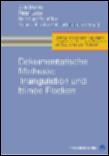Dokumentarische Methode: Triangulation und blinde Flecken
| dc.contributor.editor | Dörner, Olaf | |
| dc.contributor.editor | Loos, Peter | |
| dc.contributor.editor | Schäffer, Burkhard | |
| dc.contributor.editor | Schondelmayer, Anne-Christin | |
| dc.date.accessioned | 2019-11-19 03:00:30 | |
| dc.date.accessioned | 2020-04-01T09:27:41Z | |
| dc.date.available | 2020-04-01T09:27:41Z | |
| dc.date.issued | 2019 | |
| dc.identifier | 1006403 | |
| dc.identifier | OCN: 1135844906 | en_US |
| dc.identifier.uri | http://library.oapen.org/handle/20.500.12657/23741 | |
| dc.description.abstract | The volume discusses the possibilities and limits of the documentary method in terms of basic theory, methodology and methodology. Triangulation is important in two ways: as a research practice in itself and as a way of identifying blind spots. The interest in the topic of triangulation - taking on different perspectives - relates above all to questions about the possibilities and limits offered by the documentary method for triangulation in terms of basic theory, methodology, and method. This goes beyond the common understanding of triangulation as mixed methods, which involves the combination of different methods and the validation of results. The second part of the book deals with "blind spots" of the documentary method, which become clear in comparison with other methodologies and procedures of empirical social and educational research, but which are also constituted and revealed in the actual research practice (in the field of research). Both dimensions are taken into account in the volume.; Der Band diskutiert in grundlagentheoretischer, methodologischer und methodischer Hinsicht Möglichkeiten und Grenzen der Dokumentarischen Methode. Triangulation ist dabei in doppelter Weise von Bedeutung: einmal als Forschungspraxis an sich und einmal als Möglichkeit der Identifikation blinder Flecken. Das Interesse am Thema Triangulation – Einnahme unterschiedlicher Perspektiven – bezieht sich vor allem auf Fragen danach, welche Möglichkeiten und Grenzen die Dokumentarische Methode für Triangulationen in grundlagentheoretischer, methodologischer und methodischer Hinsicht bietet. Damit wird über das gängige Verständnis von Triangulation als Mixed Methods hinausgegangen, bei dem es um die Kombination verschiedener Methoden und die Validierung von Ergebnissen geht. Im zweiten Teil des Buches geht es um „Blinde Flecken“ der Dokumentarischen Methode, die im Vergleich mit anderen Methodologien und Verfahren der empirischen Sozial- und Bildungsforschung deutlich werden, sich aber auch in der eigentlichen Forschungspraxis (im Forschungsfeld) konstituieren und offenbaren. Im Band werden beide Dimensionen berücksichtigt. | |
| dc.language | German | |
| dc.relation.ispartofseries | Beiträge des Centrums für qualitative Evaluations- und Sozialforschung (ces) zur dokumentarischen Methode | |
| dc.subject.classification | thema EDItEUR::G Reference, Information and Interdisciplinary subjects::GP Research and information: general::GPS Research methods: general | en_US |
| dc.subject.other | Social research & statistics | |
| dc.title | Dokumentarische Methode: Triangulation und blinde Flecken | |
| dc.type | book | |
| oapen.identifier.doi | 10.3224/84742074 | |
| oapen.relation.isPublishedBy | c71f4dcb-6466-4fde-8a25-0516cdd477b8 | |
| oapen.relation.isbn | 9783847420743 | |
| oapen.series.number | 1 | |
| oapen.pages | 154 | |
| oapen.place.publication | Leverkusen-Opladen | |
| oapen.identifier.ocn | 1135844906 |

